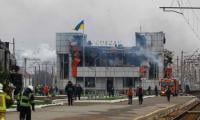Pakistan’s economy is currently in a state of urgent transformation. While there have been some positive signs in the early part of FY25 – such as a decrease in headline inflation to multi-decade lows, a surplus in the current account, and the lowest fiscal deficit since FY05 – these improvements are not enough. They are supported by disciplined monetary policy, fiscal consolidation, and the IMF’s Extended Fund Facility (EFF) programme, but the situation remains precarious.
Yet, beneath these green shoots lies a fragile foundation. The broader global and regional environment remains volatile. The recent World Bank’s Commodity Markets Outlook highlights a new norm in commodity markets: price cycles that are now twice as intense and occur half the time compared to historical averages. These rapid fluctuations introduce acute macroeconomic stress for countries like Pakistan, which rely heavily on commodity imports.
This growing volatility is not just a distant concern; it is aggravated by the recent resurgence of geopolitical tensions between India and Pakistan. These tensions, rooted in renewed cross-border incidents and nationalistic rhetoric, risk worsening commodity market disruptions through trade restrictions, increased energy insecurity and rising regional risk premiums. At a time when Pakistan needs to stabilise its fiscal outlook and accelerate structural reforms, this volatile mix of external and regional shocks poses serious challenges.
Following the deadly Pahalgam incident in Occupied Kashmir, India suspended the Indus Waters Treaty, a cornerstone of regional cooperation since 1960. This abrupt move poses a serious threat to Pakistan’s water security and, by extension, its already stressed agricultural sector. Agriculture, which accounts for 19 per cent of GDP and employs around 38 per cent of the labour force, is now at the intersection of geopolitical risk and climate vulnerability.
The State Bank of Pakistan (SBP) already flags poor performance in kharif crops due to weather shocks, policy uncertainty and low input usage. Any further disruption from reduced Indus water flows could trigger sharp drops in output, escalating food inflation just as the country begins to recover from earlier price spikes. This not only complicates fiscal planning but also undermines long-term food security and rural stability.
At the same time, global commodity dynamics are shifting in unpredictable ways. Post-pandemic, the average commodity cycle has halved from 90 months to just 45, with booms becoming more aggressive and slumps more frequent. The implications for Pakistan are severe, as 40 per cent of imports consist of oil, food, and fertilizer; price surges in any of these categories can upend budgetary projections. While the SBP projects inflation to remain within a range of 5.5–7.5 per cent for FY25, this outlook is contingent on stable global prices and continued fiscal restraint.
Rising India-Pakistan tensions add further uncertainty. Regional instability could disrupt trade corridors, trigger a reallocation of fiscal resources toward defence, and increase shipping insurance premiums. These pressures are hazardous for Pakistan, a net energy importer vulnerable to LNG and petroleum price spikes, especially in geopolitically tense environments.
The recent improvements, such as a 1000-basis-point cut in the policy rate and a rebound in private sector credit are largely driven by easing inflation and restoring confidence. However, these gains could quickly be reversed if volatility in global commodities or regional trade intensifies.
Despite improving short-term metrics, long-term structural problems persist. The SBP’s special chapter on productivity underscores how weak total factor productivity has made the economy prone to boom-bust cycles. This calls for urgent structural reforms to enhance competitiveness, improve energy efficiency and revamp agriculture, especially under the looming threat of water insecurity.
In such an environment, fiscal planning becomes a guessing game. The new volatility poses a critical threat to fiscal planning in Pakistan, where fiscal space is already limited. For instance, fluctuating oil prices can derail subsidy budgets and alter the fiscal deficit trajectory in a matter of weeks. Pakistan’s fiscal framework lacks the resilience to absorb these shocks. Revenue mobilisation remains weak, with the tax-to-GDP ratio still around 10 per cent, and non-discretionary spending, particularly on interest payments and defence, dominates the budget.
So, how should Pakistan respond? One promising option is to explore a sovereign commodity stabilisation fund. This fund, modelled after the frameworks used by Chile or Ghana, would be a financial tool to buffer against price fluctuations in essential imports. Second, reinvigorating economic backchannels with India, particularly around water and trade cooperation, is essential. Water security is not just a strategic issue but a survival issue. Economic stability is a mutual interest that can serve as a foundation for broader peace talks.
Third, budget frameworks must include flexible expenditure tools, like contingent allocations and rolling baselines. These tools allow for faster adjustment to commodity price shifts, ensuring that critical development spending is not sacrificed when shocks occur. Fourth, provinces must localise food production through investments in climate-resilient seeds, irrigation systems and cold-chain logistics. Agricultural self-sufficiency has moved from policy aspiration to national necessity.
It’s time for Pakistan to accelerate its energy diversification. Investing in solar and hydropower is no longer just about environmental responsibility, it’s about reducing foreign exchange pressure and insulating the economy from oil price volatility. Similarly, macroeconomic planning must shift from static projections to scenario-based modelling, allowing policymakers to plan for high- and low-volatile environments. The key is to be prepared for any eventuality.
The SBP rightly projects real GDP growth (2.5–3.5 per cent) but flags downside risks, especially from lower wheat harvests and continued global uncertainty. In this context, reform cannot wait for calmer conditions. As the World Bank stresses, volatility is here to stay, driven by climate change, energy transition and
global fragmentation.
Pakistan has a narrow window of opportunity. With improving reserves, reduced inflation and temporary fiscal breathing space, now is the time to rebuild resilience. The country can no longer afford the luxury of reactive policymaking. Reform must not only continue, but it must also accelerate. Pakistan must reform in the storm, not wait for fair weather.
The writer is a senior lecturer in finance, leading International and Transnational Education at Birmingham City University’s College of Accountancy, Finance and Economics. He tweets @HafizUsmanRana















